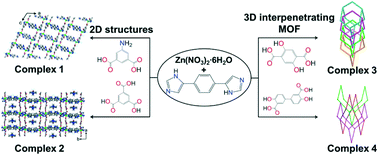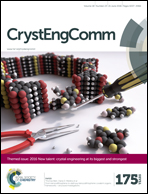Two- and three-dimensional Zn(ii) coordination polymers constructed from mixed ligand systems: interpenetration, structural transformation and sensing behavior†
Abstract
Four Zn(II) coordination compounds (1–4) were prepared solvothermally by reacting Zn2+ ions and organic linkers of dim and carboxylic acid-based ligands. Two-dimensional structures (1 and 2), which are extended to three-dimensional frameworks with the assistance of multiple hydrogen bonding interactions, are formed by employing isophthalate-based organic ligands. 4-fold (3) and 3-fold (4) interpenetrations occur when organic linkers that have carboxylic acid groups located oppositely are used. Interestingly, the interpenetrating nets undergo phase transformation via two pathways involving solvent exchange/resolvation and solvent exchange/activation/resolvation, which reveals that the structures are flexible. Photoluminescence properties show the selective fluorescence quenching of 3 and 4 in nitrobenzene (NB) among the tested solvents. Such quenching is substantial even at low NB concentrations, which is associated with the existence of Lewis basic sites in the interpenetrating framework.

- This article is part of the themed collection: 2016 New talent

 Please wait while we load your content...
Please wait while we load your content...